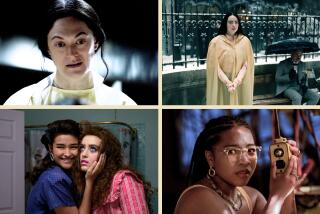Real Story of a Guy and His Monster : Movies: Countless films have altered Shelley’s ‘Frankenstein’ novel. Now, TNT will try to set things right.
- Share via
IVER HEATH, England — Harsh winds are stirring up such a thick cloud of snow across this patch of frozen tundra that it’s difficult to see the team of huskies pulling the oversized sled in the distance.
The dogs yelp with enthusiasm as they race past a snowdrift and circle back toward their starting point.
It’s a mighty surprising scene for the unprepared observer.
The surprise has nothing to do with the fact that this is all taking place just outside London on a warmish autumn day. This is, after all, Pinewood Studios, one of the most famous movie lots in the world. Here, creating a realistic Arctic setting, should be a snap. Next to the tundra is a hulking soundstage marked “007” where some of James Bond’s most amazing feats have been filmed.
What’s remarkable about this icy milieu is that it’s been painstakingly constructed, in the name of strict authenticity, to film the opening sequence of a new movie about Frankenstein.
Frankenstein on a dog sled in the Arctic Circle? It’s a weird idea that probably would have been deemed utterly preposterous and tossed in the trash if not for the person who thought of it. That person was Mary Shelley, whose 1818 novel “Frankenstein” begins with a disfigured creature and its creator locked in a deadly chase across the great white North.
Boris Karloff and the legion of square-headed descendants who have played the Frankenstein monster in countless films may have provided hours of thrilling entertainment with their versions of the creature. But what really wound up hideously disfigured in those movies was Shelley’s novel.
Now comes Turner Network Television to set things right.
The cable channel is producing the most true-to-the-original-story version of Frankenstein that has ever been filmed, with Randy Quaid as the monster (no, his name is not Frankenstein) and Patrick Bergin as his creator, (his name is Frankenstein).
Production on the renowned monster tale is wrapping up just as another classic horror story--Francis Ford Coppola’s awkwardly titled “Bram Stoker’s Dracula”--arrives in theaters. With Coppola just announcing that his American Zoetrope will produce a new version of Frankenstein starring and directed by Kenneth Branagh, there appears to be something of a mini-trend toward recharging the careers of aging frightmeisters.
Even Godzilla is returning, in a recently announced TriStar Pictures production.
The simultaneous development of TNT’s “Frankenstein” and Coppola’s “Dracula” was just a coincidence, of course. But TNT executive Laurie Pozmantier-Fudge says there is an obvious appeal for moviemakers to return to well-known horror tales.
“I think the studios like to go back to the classics because the stories are familiar to audiences, actors love to be in them and the films will stay popular over the years,” she says. “It’s a win-win situation.”
The notion of filming the original Frankenstein story began with writer-director-producer David Wickes, whose credits include such scary tales as “Jekyll and Hyde” and “Jack the Ripper.”
“I read the story like everyone else when I was at school,” says the British
filmmaker, as he sits near a pack of baying huskies on the Arctic set. “I was fascinated by it and loved it and it remained an image forever.” He saw all the Frankenstein movies and always felt that they “didn’t live up to what I had read.”
The novel raises profound moral questions as it tells the story of Dr. Frankenstein and the creature he brings to life in his laboratory.
“Mary Shelley’s story is much better than anything else that’s been on film,” says Wickes. “She addresses big issues. Is it right to play God? And does this creature have a soul? What is a soul? Does such a thing exist? Very tricky.”
Quaid, who won acclaim for his work in such films as “The Last Picture Show,” “The Last Detail” and “LBJ: The Early Years,” says he was eager to play the Frankenstein monster as it was originally conceived.
“He starts out innocent and develops into a very destructive creature,” says the actor, sitting in the makeup room, undergoing the daily four-hour ritual that mutates him into the aesthetically challenged being.
“It’s other people and how they relate to him that cause him to turn into a violent killer. But he has a good heart. He wants to be accepted by other people, but because of the way he looks, it puts a barrier between him and the world.”
In playing the role, Quaid wanted to highlight the emotional turmoil of his character. “I’ve tried to emphasize the human qualities of the monster and let the makeup take care of the monster side,” he says, his face an orgy of protrusions and discoloring.
Wickes finally decided to pursue his idea for the film after a dinner party during which the table talk centered on genetic engineering and the possibility of not only choosing a baby’s gender but also its level of intelligence.
“I said, ‘Well, it’s like the Frankenstein story,’ and someone at the table said, ‘You mean the monster with the bolts through the neck?’ And I thought, ‘Hey, now’s the time’ ” to shoot the original version.
An obvious question arises. If the original story is so good, why hasn’t anyone filmed it before?
“When I started to transpose the novel to movie script, I realized how difficult it was,” he says. “A novel is a very different thing from a movie. There are long introspective thoughts (in the book), exhaustively discussed, dismembered and examined under microscopic intensity. You cannot do that in a picture. A picture has to have events and images, dialogue and relationships.”
TNT executives not only believed the transformation was possible, they found the idea irresistible. “It had all the elements we look for,” says Pozmantier-Fudge, TNT’s executive in charge of developing and producing original programming. “A classic the whole family can watch, big entertainment, big production values, a lot of interesting moral story lines to deal with. With TNT films, we look for something that’s an alternative to what you’d see on the networks.”
Although TNT’s slate of high-profile movies make up only a minimal portion of its programming, they play a valuable role for the network, says Pozmantier-Fudge. “They entice cable subscribers and boost the image of the network. They make money and we own them--they become part of the library. We see them as having long-term value.”
“Frankenstein” has a higher budget than the typical network movie--about $4.5 million--and, at 2 1/2 hours, will run longer. For budgetary as well as scenic reasons, most of the filming was done in Poland. Only the Arctic sequences were shot in England.
The movie’s budget could rise slightly higher as a result of an on-set accident that left Bergin temporarily unable to work. On what was to be the next-to-last day of shooting, the actor spilled out of his moving sled and broke his arm. Because of the mishap, filming of his last scenes had to be postponed.
But with the last sequences scheduled for filming this week, the movie remains on target for its premiere next spring.
More to Read
The complete guide to home viewing
Get Screen Gab for everything about the TV shows and streaming movies everyone’s talking about.
You may occasionally receive promotional content from the Los Angeles Times.






